At NRPA, research and evalutation is our capacity for defining, measuring, and understanding impact, a meaningful improvement for people and places beyond what would have happened without NRPA and the broader field of parks and recreation.
The typical park and recreation agency offers one park for every 2,411 residents served, with 10.2 acres of parkland per 1,000 residents. But park and recreation agencies are as diverse as the communities that they serve, and what works well for one agency may not be best for your agency. Therefore, park and recreation professionals need data to identify the best practices to optimally serve their community.
That is where the 2025 NRPA Agency Performance Review comes in. This report is the most comprehensive resource of data and insights for park and recreation agencies in the United States. The report highlights 27 of the most critical park and recreation metrics collected from the NRPA Park Metrics database. Additional data breaks are available below or you can customize your own report by logging into NRPA Park Metrics.
Read the Report
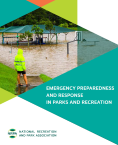
Preparing for and responding to emergencies are among the many essential responsibilities of park and recreation professionals. Whether through the implementation of stormwater infrastructure for flood control, or the provision of temporary shelters and emergency care during natural disasters, park and recreation professionals support their communities in times of greatest need. The Emergency Preparedness and Response in Parks and Recreation report highlights the experiences, challenges and opportunities that are found as park and recreation professionals navigate the landscape of emergency preparedness and response within their communities.

The Youth Sports in Parks and Recreation report describes the state of youth sports programming provided by parks and recreation. In addition to highlighting the types of youth sports offered, the report recognizes the role of park and recreation professionals in addressing gaps in participation rates of girls and advancing equity so that all youth can experience the benefits of youth sports. The information presented in this report provides baseline data and a tool for advocacy and program development of accessible youth sports programming for all.

Each year, NRPA conducts a study exploring the public's relationship with their local parks. This study examines the essential nature of local parks and recreation, including how parks play a role in deciding where to live, the number of local parks, trails and other open spaces within easy access to people's homes, and the public's opinions on the use of automated counting technology being used at their local park and recreation facilities. The 2024 Engagement With Parks Report examines the role of parks and recreation in everyday life and more.
 Park and recreation agencies across the United States increasingly are looking to automated counting technologies to collect visitation numbers, inform planning and design, improve management and operations, measure economic impact, and support equity. Using these technologies helps to alleviate the manual and time-intensive studies conducted by many agencies and reduces the need to pull staff from their day-to-day activities to perform these tasks.
Park and recreation agencies across the United States increasingly are looking to automated counting technologies to collect visitation numbers, inform planning and design, improve management and operations, measure economic impact, and support equity. Using these technologies helps to alleviate the manual and time-intensive studies conducted by many agencies and reduces the need to pull staff from their day-to-day activities to perform these tasks.
The public most strongly supports agencies using monitoring systems like cameras, counters and cell phone data for the purposes of safety and for understanding park and recreation spaces.
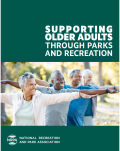
Park and recreation agencies across the United States provide essential services and programs to members of all ages of their community. One of the largest groups in nearly every community is comprised of adults older than 55, often termed “older adults.”
A survey was completed by park and recreation professionals to gain greater insight into how they and their staff serve older adults in the community. Participants answered questions regarding the facilities, services, outreach and programming that their agencies offer to older adults, as well as the challenges agencies face in serving this ever-growing population. The Supporting Older Adults Through Parks and Recreation report summarizes the data from those responses.

Park and recreation agencies play a pivotal role in facilitating community engagement by providing a space for all members of the community to come together. This role becomes especially vital during the summer months, as parks serve as essential hubs for youth activities, on which parents heavily rely. The effective operation of these programs could not be achieved without the unwavering commitment of the summer seasonal workforce. However, agencies grapple with matching the wages offered by other competing summer employers, lengthy hiring processes and the logistical issue of seasonal staff being unable to commit to the entire duration of the summer season. The Summer Seasonal Hiring Report outlines the recruitment and hiring process of these temporary employees, how challenges are managed at agencies and the first-hand techniques used by professionals leading to a successful season.
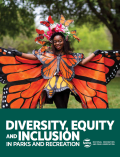
In early 2023, the NRPA Research team surveyed park and recreation leaders to gain a better understanding of their agencies’ efforts to improve access and opportunity for staff and community. The survey, a follow up from a similar 2021 study, took inventory of park and recreation agency activities, the professional development opportunities provided to staff, and the challenges organizations face in their efforts. The survey’s responses from park and recreation leaders across the United States are the basis of this report.

The 2024 NRPA Park and Recreation Salary Survey Report presents compensation data provided by agency size, type and certain demographic characteristics of incumbents in the positions (e.g., education, certifications and years in the profession). The analysis also examines factors that determine pay raises and bonuses (if offered) and highlights other benefits that comprise full compensation packages for park and recreation professionals.
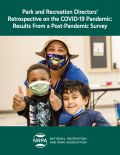
The response by park and recreation professionals and their agencies during the pandemic highlighted how their work is essential to vibrant, healthy and equitable communities. Thanks to the hard work of the more than 160,000 full-time park and recreation professionals, along with hundreds of thousands of part-time and volunteer workers, agencies across the nation quickly pivoted resources and programming to support the public health emergency response.
Now several years removed from the start of the pandemic, the Park and Recreation Directors’ Retrospective on the COVID-19 Pandemic: Results From a Post-Pandemic Survey report takes a look at how parks and recreation responded to the challenges of COVID-19.
 NRPA’s Sustainability in Parks and Recreation report highlights how park and recreation professionals are working to make their agencies and their communities more sustainable through such actions as protecting natural habitat, embracing park infrastructure, managing stormwater effectively and lowering agency water usage. Park and recreation professionals continually review and update their plans to address communities’ specific needs and goals while leveraging the latest knowledge, best practices and technology to advance sustainable efforts. This report showcases park and recreation agencies’ innate role as sustainability leaders in their communities.
NRPA’s Sustainability in Parks and Recreation report highlights how park and recreation professionals are working to make their agencies and their communities more sustainable through such actions as protecting natural habitat, embracing park infrastructure, managing stormwater effectively and lowering agency water usage. Park and recreation professionals continually review and update their plans to address communities’ specific needs and goals while leveraging the latest knowledge, best practices and technology to advance sustainable efforts. This report showcases park and recreation agencies’ innate role as sustainability leaders in their communities.

NRPA partnered with the Urban Institute to develop resources that help park and recreation professionals and advocates make a health-based case for parks, including measures of the economic value to those health benefits. Explore the following resources to measure and communicate about the health and economic benefits of parks:
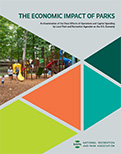 NRPA’s The Economic Impact of Local Parks report not only demonstrates that the nation’s local parks generate more than $201 billion in economic activity per year and support almost 1.1 million jobs from operations and capital spending alone, but also highlights the significant economic contributions of local parks in all 50 states and the District of Columbia. This report demonstrates that parks are powerful engines of valuable economic activity and deserve support and recognition from elected officials, policymakers and the public. officials, policymakers and the public.
NRPA’s The Economic Impact of Local Parks report not only demonstrates that the nation’s local parks generate more than $201 billion in economic activity per year and support almost 1.1 million jobs from operations and capital spending alone, but also highlights the significant economic contributions of local parks in all 50 states and the District of Columbia. This report demonstrates that parks are powerful engines of valuable economic activity and deserve support and recognition from elected officials, policymakers and the public. officials, policymakers and the public.
 More than four in five park and recreation agencies offer out-of-school time (OST) programs that serve millions of children throughout the United States. These before-school, after-school and/or summer programs provide physical activity opportunities, safe spaces for children, childcare for parents and caregivers, and social connections with peers. The 2021 NRPA Out-of-School Time Report looks at those offerings and benefits of OST programs provided by local parks and recreation. Additionally, the report delves into innovations to OST programs brought on by the coronavirus (COVID-19) pandemic, limitations found in providing additional or expanded program offerings due to funding and workforce shortages, and partner opportunities.
More than four in five park and recreation agencies offer out-of-school time (OST) programs that serve millions of children throughout the United States. These before-school, after-school and/or summer programs provide physical activity opportunities, safe spaces for children, childcare for parents and caregivers, and social connections with peers. The 2021 NRPA Out-of-School Time Report looks at those offerings and benefits of OST programs provided by local parks and recreation. Additionally, the report delves into innovations to OST programs brought on by the coronavirus (COVID-19) pandemic, limitations found in providing additional or expanded program offerings due to funding and workforce shortages, and partner opportunities.
 The renovation of Baltimore’s ABC/Catherine Street Park (ABC Park) through NRPA’s Parks Build Community program resulted in several bright spots for the community. Parents were highly satisfied with the new amenities, and children and families more frequently visited the park to take advantage of the upgraded playground and exercise equipment. Economic and safety improvements in the surrounding neighborhood coincided with the revitalization of the park and outshone those for the matched comparison park in the vicinity. This report is a summation of the Five-Year Evaluation of the 2019 NRPA Parks Build Community Project in Baltimore.: Download Report
The renovation of Baltimore’s ABC/Catherine Street Park (ABC Park) through NRPA’s Parks Build Community program resulted in several bright spots for the community. Parents were highly satisfied with the new amenities, and children and families more frequently visited the park to take advantage of the upgraded playground and exercise equipment. Economic and safety improvements in the surrounding neighborhood coincided with the revitalization of the park and outshone those for the matched comparison park in the vicinity. This report is a summation of the Five-Year Evaluation of the 2019 NRPA Parks Build Community Project in Baltimore.: Download Report
 To meet the emerging health and wellness needs of the public, parks and recreation — in partnership with community members — is evolving into community wellness hubs. These hubs are trusted gathering places that allow every member of a community to connect with essential programs, services and spaces that advance health equity, improve health outcomes and enhance quality of life. The Parks and Recreation: Advancing Community Health and Well-Being report focuses on how park and recreation professionals are tackling the ever-expanding health and wellness needs of their communities, including programming, education, innovations and health equity.
To meet the emerging health and wellness needs of the public, parks and recreation — in partnership with community members — is evolving into community wellness hubs. These hubs are trusted gathering places that allow every member of a community to connect with essential programs, services and spaces that advance health equity, improve health outcomes and enhance quality of life. The Parks and Recreation: Advancing Community Health and Well-Being report focuses on how park and recreation professionals are tackling the ever-expanding health and wellness needs of their communities, including programming, education, innovations and health equity.
 The Workforce Development and Career Exploration in Park and Recreation report explores the benefits and goals of workforce development and career exploration programs, how these programs are offered at agencies, the role of partners in connecting participants to jobs, and the program-related challenges facing many agencies.
The Workforce Development and Career Exploration in Park and Recreation report explores the benefits and goals of workforce development and career exploration programs, how these programs are offered at agencies, the role of partners in connecting participants to jobs, and the program-related challenges facing many agencies.
The report highlights the role park and recreation professionals and their agencies play in preparing youth and young adults for their future regardless of whether they continue to work in parks and recreation. Workforce development or career exploration programs expose youth and young adults to a wide range of jobs allowing participants to build self-confidence, gain valuable work experience and develop foundational skills, such as communications and financial literacy.
 Park and recreation professionals and their agencies are major providers of both organized and unorganized sports program facilities across the nation. Equity is at the heart of access to youth sports. Studies demonstrate that gender, household formation and income correlate with children’s engagement with organized sports, what sports they may play and how long they engage in those activities. Unfortunately, there are significant disparities in who has access to youth sports opportunities.
Park and recreation professionals and their agencies are major providers of both organized and unorganized sports program facilities across the nation. Equity is at the heart of access to youth sports. Studies demonstrate that gender, household formation and income correlate with children’s engagement with organized sports, what sports they may play and how long they engage in those activities. Unfortunately, there are significant disparities in who has access to youth sports opportunities.
The Youth Sports at Park and Recreation Agencies report explores youth sports offerings, partnerships, fees and registration, and equitable access. The report also takes a look at the impact of COVID-19 on youth sports during the summer and fall of 2020.
 The majority of the nation’s more than 10,000 park and recreation agencies rely on taxpayer support and generated revenue as their primary funding sources. Unfortunately, the typical agency does not receive sufficient funding to fully deliver on its mission. As a result, many park and recreation agencies partner with nonprofit park foundations or “friends groups” to ensure every community member has access to high-quality park and recreation programming and facilities. Read this report for evidence-based best practices that optimize these relationships and for a detailed snapshot of the benefits and challenges that exist between agency-foundation relationships.
The majority of the nation’s more than 10,000 park and recreation agencies rely on taxpayer support and generated revenue as their primary funding sources. Unfortunately, the typical agency does not receive sufficient funding to fully deliver on its mission. As a result, many park and recreation agencies partner with nonprofit park foundations or “friends groups” to ensure every community member has access to high-quality park and recreation programming and facilities. Read this report for evidence-based best practices that optimize these relationships and for a detailed snapshot of the benefits and challenges that exist between agency-foundation relationships.
 The NRPA Park and Recreation Marketing and Communications Report examines the methods and means agencies use to share their vast array of offerings to the community. Getting the word out to the public about what park and recreation agencies do is a great challenge. One solution to this challenge is for agencies to invest in marketing and communications strategies—although accomplishing this is no small feat. Building awareness, boosting revenue and enhancing public support and engagement are key goals for park and recreation marketing and communications strategies. This survey explores the various methods and tactics used to market to community members, the use of partners for greater reach, the role of social media in marketing and communications, typical budgets and number of personnel devoted to this effort, and much more.
The NRPA Park and Recreation Marketing and Communications Report examines the methods and means agencies use to share their vast array of offerings to the community. Getting the word out to the public about what park and recreation agencies do is a great challenge. One solution to this challenge is for agencies to invest in marketing and communications strategies—although accomplishing this is no small feat. Building awareness, boosting revenue and enhancing public support and engagement are key goals for park and recreation marketing and communications strategies. This survey explores the various methods and tactics used to market to community members, the use of partners for greater reach, the role of social media in marketing and communications, typical budgets and number of personnel devoted to this effort, and much more.
 The Farmers Markets: Parks and Recreation Connecting Communities to Healthy Foods report explores the role park and recreation agencies play in bringing farmers markets to their communities. The report explores markets’ product and services offerings—spanning from fresh produce and protein to entertainment and educational programming, as well as the organizations that agencies partner with to make their markets successful and the challenges they must overcome.
The Farmers Markets: Parks and Recreation Connecting Communities to Healthy Foods report explores the role park and recreation agencies play in bringing farmers markets to their communities. The report explores markets’ product and services offerings—spanning from fresh produce and protein to entertainment and educational programming, as well as the organizations that agencies partner with to make their markets successful and the challenges they must overcome.
 NRPA's Promoting Parks and Recreation's Role in Economic Development report explored the role that quality park amenities play in 21st century regional economic development. Based on conversations with more than 70 park and recreation professionals, economic development practitioners and site-location consultants, this report highlights the important supporting role parks and recreation in recruiting and retaining businesses and skilled workers.
NRPA's Promoting Parks and Recreation's Role in Economic Development report explored the role that quality park amenities play in 21st century regional economic development. Based on conversations with more than 70 park and recreation professionals, economic development practitioners and site-location consultants, this report highlights the important supporting role parks and recreation in recruiting and retaining businesses and skilled workers.
 NRPA developed the Parks and Recreation Inclusion Report to provide greater insight into how agencies across the United States ensure that all members of their communities can enjoy parks and recreation. The study also highlights the significant challenges facing the industry in delivering on this promise.
NRPA developed the Parks and Recreation Inclusion Report to provide greater insight into how agencies across the United States ensure that all members of their communities can enjoy parks and recreation. The study also highlights the significant challenges facing the industry in delivering on this promise.
 Parks and recreation is predominantly a service provided by local governments and therefore is reliant on financial support from local governments’ general tax funds. However, local governments fund and manage a variety of different public services. This report will help park and recreation professionals understand how local government officials view and prioritize these services. Read more about the study here.
Parks and recreation is predominantly a service provided by local governments and therefore is reliant on financial support from local governments’ general tax funds. However, local governments fund and manage a variety of different public services. This report will help park and recreation professionals understand how local government officials view and prioritize these services. Read more about the study here.
 Parks are key community stakeholders when it comes to addressing the effects of climate change. From protecting water resources via green infrastructure practices, to reducing urban heat island effect through city wide forest restoration - parks play a critical role in ensuring that our communities successfully adapt and thrive in light of a rapidly changing planet.
Parks are key community stakeholders when it comes to addressing the effects of climate change. From protecting water resources via green infrastructure practices, to reducing urban heat island effect through city wide forest restoration - parks play a critical role in ensuring that our communities successfully adapt and thrive in light of a rapidly changing planet.
For more information about research papers, contact NRPA Customer Service at 800.626.NRPA (6772)


